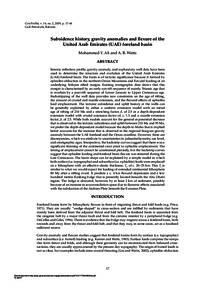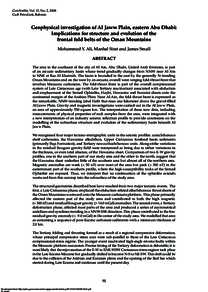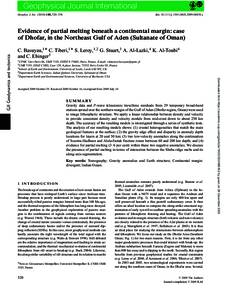Document
Subsidence history, gravity anomalies and flexure of the United Arab Emirates (UAE) foreland basin.
Identifier
DOI: 10.2113/geoarabia140217
Contributors
Watts, A. B., Author
Publisher
Gulf PetroLink.
Gregorian
2009-04
Language
English
English abstract
Seismic reflection profile, gravity anomaly, and exploratory well data have been used to determine the structure and evolution of the United Arab Emirates (UAE) foreland basin. The basin is of tectonic significance because it formed by ophiolite obduction in the northern Oman Mountains and flexural loading of an underlying Tethyan rifted margin. Existing stratigraphic data shows that this margin is characterised by an early syn-rift sequence of mainly Triassic age that is overlain by a post-rift sequence of Lower Jurassic to Upper Cretaceous age. Backstripping of the well data provides new constraints on the age of rifting, the amount of crustal and mantle extension, and the flexural effects of ophiolite load emplacement. The tectonic subsidence and uplift history at the wells can be generally explained by either a uniform extension model with an initial age of rifting of 210 Ma and a stretching factor, β, of 2.5 or a depth-dependant extension model with crustal extension factor of, γ, 1.3 and a mantle extension factor, β, of 2.5. While both models account for the general exponential decrease that is observed in the tectonic subsidence and uplift between 210 Ma and 95 Ma, we prefer the depth-dependant model because the depth-to-Moho that is implied better accounts for the increase that is observed in the regional Bouguer gravity anomaly between the UAE foreland and the Oman coastline. However, there are discrepancies, which we attribute to uncertainties in palaeobathymetry, sea level, and stratigraphic ages. Irrespective, the backstrip curves suggest that there was a significant thinning of the continental crust prior to ophiolite emplacement. The timing of emplacement cannot be constrained precisely, but the backstrip curves suggest that ophiolite loading and foreland basin flexure was initiated during the Late Cretaceous. The basin shape can be explained by a simple model in which both surface (i.e. topographic) and subsurface (i.e. ophiolitic) loads were emplaced on a lithosphere with an effective elastic thickness, Te, of c. 20-25 km. This Te is similar to what we would expect for loading of extended continental lithosphere 80 My after a rifting event. It predicts a c. 4 km flexural depression and a few hundred metres flanking bulge that is presently located beneath the Abu Dhabi region. The bulge is obscured, however, by at least 2 km of sediment, possibly because of an increase in accommodation space due to dynamic effects associated with the subduction of the Arabian Plate beneath the Eurasian Plate.
Member of
ISSN
1025-6059
Resource URL
Category
Journal articles



